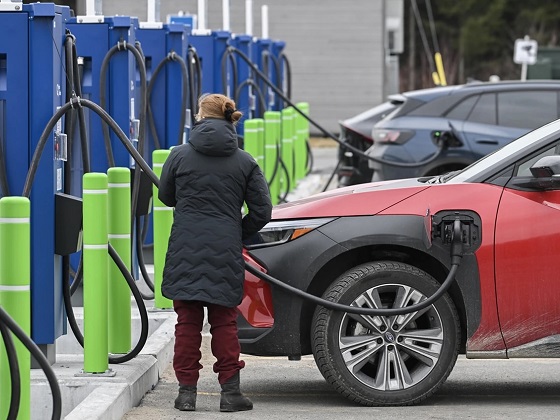Automotive
Repeal the EV mandate, Mr. Carney

By Dan McTeague
Earlier this month, Donald Trump fulfilled a major campaign promise and struck a blow against environmentalist governance in Canada, all in one fell swoop.
He did this by signing a congressional resolution revoking a waiver granted to California by the Biden Administration that enabled the state to set automotive emissions standards significantly stricter than the national standard. So strict, in fact, that in practice only electric vehicles (EVs) could realistically meet them.
This waiver functioned as a backdoor EV mandate, not just in California, but for all of the United States. That’s because automakers don’t want to be locked out of the most populous state in the union but are also disinclined to build one set of cars for California and another for the rest of the country. Their only option would be to increase their production of EVs, to the exclusion of gas-and-diesel internal combustion engine (ICE) vehicles.
Trump has argued, both during his 2024 campaign and since, that the waiver enabled far-left California to saddle the rest of the country with environmental policies it had never voted for and couldn’t repeal. That view helped him win back the White House.
But what does this have to do with Canada? Donald Trump has no power over our own EV mandate. The law of the land in Canada, though it was barely discussed in this spring’s federal election, beyond a last-minute pledge from Pierre Poilievre to reverse it, is still that by 2035, 100 per cent of new light-duty vehicles sold in Canada (including passenger cars, pickup trucks, and SUVs) must be electric.
It doesn’t sound like Mark Carney’s Liberals have any intention of changing course from this Trudeau-era policy — even though new EVs sold in Canada have been falling as a share of overall purchases. To stay on track for 2035, the mandate stipulates, 20 per cent of new cars sold in Canada next year must be EVs. Last year just 13.7 per cent were. And, as Tristin Hopper noted recently, “these sales are disproportionately concentrated in a single province … Of the 81,205 zero-emission vehicles sold in Canada in the last quarter of 2024, 49,357 were sold in Quebec.”
That doesn’t bode well for a national mandate. And Trump’s move further complicates the Liberals’ EV mandate, which has always been presented as an investment opportunity as well as a chance to reduce global carbon emissions. Our federal and provincial governments (particularly Ontario and Quebec) have bet very big on EVs dominating the future. Last year, the Parliamentary Budget Officer estimated that public investment in EVs exceeded $52 billion. Much of that money has gone towards subsidizing the manufacture of EVs in Canada.
Except there just aren’t enough Canadian consumers to justify that expense. The scheme has always hinged on there being a robust EV market south of the border. The Canadian Vehicle Manufacturers Association reminds us that “vehicles are the second largest Canadian export by value, at $51 billion in 2023, of which 93 per cent was exported to the U.S.”
The assumption was that existing avenues of trade would remain essentially unchanged. Even leaving aside concerns about what our future trade relationship with the United States will be, the end of America’s backdoor mandate — and with it, any reason to believe there will be a serious market for EVs in the U.S. — exposes our current EV policies as a bum deal.
Of course, there was never a strong case for attempting to turn Canada into a global EV superpower. There’s a reason Canadian consumers remain skeptical of them. EV batteries don’t perform well in the frigid temperatures for which our country is famous. In cold weather, they charge slowly and then struggle to hold the charge.
Our already-stressed electrical grid isn’t ready for the extra demand that would come with widespread EV adoption, especially considering the Liberals’ desire to progressively decarbonize the grid. And we have nothing like the infrastructure we would need to support this transition.
These roadblocks have now become so obvious that even the automakers, the main beneficiaries of both taxpayer-funded largesse and the mandates themselves, have started saying so. “The fact is these EV sales mandates were never achievable,” read a recent statement by the Alliance for Automotive Innovation, which represents Toyota, GM, Volkswagen, and Stellantis. Ford Canada CEO Bev Goodman has described the mandate as unrealistic and called for its repeal. Kristian Aquilina, president of GM Canada, has said the same.
Whether they realize it or not, our political leaders will have to face up to this reality, and sooner rather than later. Their best option is also the most straightforward one. There’s no reason for us to keep throwing good money after bad money, nor to force an unwanted product on Canadian consumers.
You can do it, Mr. Carney. Repeal the EV mandate.
Automotive
The high price of green virtue

By Jerome Gessaroli for Inside Policy
Reducing transportation emissions is a worthy goal, but policy must be guided by evidence, not ideology.
In the next few years, the average new vehicle in British Columbia could reach $80,000, not because of inflation, but largely because of provincial and federal climate policy. By forcing zero-emission-vehicle (ZEV) targets faster than the market can afford, both governments risk turning climate ambition into an affordability crisis.
EVs are part of the solution, but mandates that outpace market acceptance risk creating real-world challenges, ranging from cold-weather travel to sparse rural charging to the cost and inconvenience for drivers without home charging. As Victoria and Ottawa review their ZEV policies, the goal is to match ambition with evidence.
Introduced in 2019, BC’s mandate was meant to accelerate electrification and cut emissions from light-duty vehicles. In 2023, however, it became far more stringent, setting the most aggressive ZEV targets in North America. What began as a plan to boost ZEV adoption has now become policy orthodoxy. By 2030, automakers must ensure that 90 per cent of new light-duty vehicles sold in BC are zero-emission, regardless of what consumers want or can afford. The evidence suggests this approach is out of step with market realities.
The province isn’t alone in pursuing EV mandates, but its pace is unmatched. British Columbia, Quebec, and the federal government are the only ones in Canada with such rules. BC’s targets rise much faster than California’s, the jurisdiction that usually sets the bar on green-vehicle policy, though all have the same goal of making every new vehicle zero-emission by 2035.
According to Canadian Black Book, 2025 model EVs are about $17,800 more expensive than gas-powered vehicles. However, ever since Ottawa and BC removed EV purchase incentives, sales have fallen and have not yet recovered. Actual demand in BC sits near 16 per cent of new vehicle sales, well below the 26 per cent mandate for 2026. To close that gap, automakers may have to pay steep penalties or cut back on gas-vehicle sales to meet government goals.
The mandate also allows domestic automakers to meet their targets by purchasing credits from companies, such as Tesla, which hold surplus credits, transferring millions of dollars out of the country simply to comply with provincial rules. But even that workaround is not sustainable. As both federal and provincial mandates tighten, credit supplies will shrink and costs will rise, leaving automakers more likely to limit gas-vehicle sales.
It may be climate policy in intent, but in reality, it acts like a luxury tax on mobility. Higher new-vehicle prices are pushing consumers toward used cars, inflating second-hand prices, and keeping older, higher-emitting vehicles on the road longer. Lower-income and rural households are hit hardest, a perverse outcome for a policy meant to reduce emissions.
Infrastructure is another obstacle. Charging-station expansion and grid upgrades remain far behind what is needed to support mass electrification. Estimates suggest powering BC’s future EV fleet alone could require the electricity output of almost two additional Site C dams by 2040. In rural and northern regions, where distances are long and winters are harsh, drivers are understandably reluctant to switch. Beyond infrastructure, changing market and policy conditions now pose additional risks to Canada’s EV goals.
Major automakers have delayed or cancelled new EV models and battery-plant investments. The United States has scaled back or reversed federal and state EV targets and reoriented subsidies toward domestic manufacturing. These shifts are likely to slow EV model availability and investment across North America, pushing both British Columbia and Ottawa to reconsider how realistic their own targets are in more challenging market conditions.
Meanwhile, many Canadians are feeling the strain of record living costs. Recent polling by Abacus Data and Ipsos shows that most Canadians view rising living costs as the country’s most pressing challenge, with many saying the situation is worsening. In that climate, pressing ahead with aggressive mandates despite affordability concerns appears driven more by green ideology than by evidence. Consumers are not rejecting EVs. They are rejecting unrealistic timelines and unaffordable expectations.
Reducing transportation emissions is a worthy goal, but policy must be guided by evidence, not ideology. When targets become detached from real-world conditions, ideology replaces judgment. Pushing too hard risks backlash that can undo the very progress we are trying to achieve.
Neither British Columbia nor the federal government needs to abandon its clean-transportation objectives, but both need to adjust them. That means setting targets that match realistic adoption rates, as EVs become more affordable and capable, and allowing more flexible compliance based on emissions reductions rather than vehicle type. In simple terms, the goal should be cutting emissions, not forcing people to buy a specific type of car. These steps would align ambition with reality and ensure that environmental progress strengthens, rather than undermines, public trust.
With both Ottawa and Victoria reviewing their EV mandates, their next moves will show whether Canadian climate policy is driven by evidence or by ideology. Adjusting targets to reflect real-world affordability and adoption rates would signal pragmatism and strengthen public trust in the country’s clean-energy transition.
Jerome Gessaroli is a senior fellow at the Macdonald-Laurier Institute and leads the Sound Economic Policy Project at the BC Institute of British Columbia
Automotive
Elon Musk Poised To Become World’s First Trillionaire After Shareholder Vote


From the Daily Caller News Foundation
At Tesla’s Austin headquarters, investors backed Musk’s 12-step plan that ties his potential trillion-dollar payout to a series of aggressive financial and operational milestones, including raising the company’s valuation from roughly $1.4 trillion to $8.5 trillion and selling one million humanoid robots within a decade. Musk hailed the outcome as a turning point for Tesla’s future.
“What we’re about to embark upon is not merely a new chapter of the future of Tesla but a whole new book,” Musk said, as The New York Times reported.
Dear Readers:
As a nonprofit, we are dependent on the generosity of our readers.
Please consider making a small donation of any amount here.
Thank you!
The decision cements investor confidence in Musk’s “moonshot” management style and reinforces the belief that Tesla’s success depends heavily on its founder and his leadership.
Tesla Annual meeting starting now
https://t.co/j1KHf3k6ch— Elon Musk (@elonmusk) November 6, 2025
“Those who claim the plan is ‘too large’ ignore the scale of ambition that has historically defined Tesla’s trajectory,” the Florida State Board of Administration said in a securities filing describing why it voted for Mr. Musk’s pay plan. “A company that went from near bankruptcy to global leadership in E.V.s and clean energy under similar frameworks has earned the right to use incentive models that reward moonshot performance.”
Investors like Ark Invest CEO Cathie Wood defended Tesla’s decision, saying the plan aligns shareholder rewards with company performance.
“I do not understand why investors are voting against Elon’s pay package when they and their clients would benefit enormously if he and his incredible team meet such high goals,” Wood wrote on X.
Norway’s sovereign wealth fund, Norges Bank Investment Management — one of Tesla’s largest shareholders — broke ranks, however, and voted against the pay plan, saying that the package was excessive.
“While we appreciate the significant value created under Mr. Musk’s visionary role, we are concerned about the total size of the award, dilution, and lack of mitigation of key person risk,” the firm said.
The vote comes months after Musk wrapped up his short-lived government role under President Donald Trump. In February, Musk and his Department of Government Efficiency (DOGE) team sparked a firestorm when they announced plans to eliminate the U.S. Agency for International Development, drawing backlash from Democrats and prompting protests targeting Musk and his companies, including Tesla.
Back in May, Musk announced that his “scheduled time” leading DOGE had ended.
-

 Daily Caller2 days ago
Daily Caller2 days ago‘Holy Sh*t!’: Podcaster Aghast As Charlie Kirk’s Security Leader Reads Texts He Allegedly Sent University Police
-

 Crime10 hours ago
Crime10 hours ago‘Modern-Day Escobar’: U.S. Says Former Canadian Olympian Ran Cocaine Pipeline with Cartel Protection and a Corrupt Toronto Lawyer
-

 Great Reset2 days ago
Great Reset2 days agoCanadian government forcing doctors to promote euthanasia to patients: report
-

 Alberta2 days ago
Alberta2 days agoSylvan Lake football coach fired for opposing transgender ideology elected to town council
-

 Health2 days ago
Health2 days agoNEW STUDY: Infant Vaccine “Intensity” Strongly Predicts Autism Rates Worldwide
-

 Carbon Tax2 days ago
Carbon Tax2 days agoCarney fails to undo Trudeau’s devastating energy policies
-

 Business1 day ago
Business1 day agoNearly One-Quarter of Consumer-Goods Firms Preparing to Exit Canada, Industry CEO Warns Parliament
-

 Daily Caller22 hours ago
Daily Caller22 hours agoDemocrats Explicitly Tell Spy Agencies, Military To Disobey Trump





